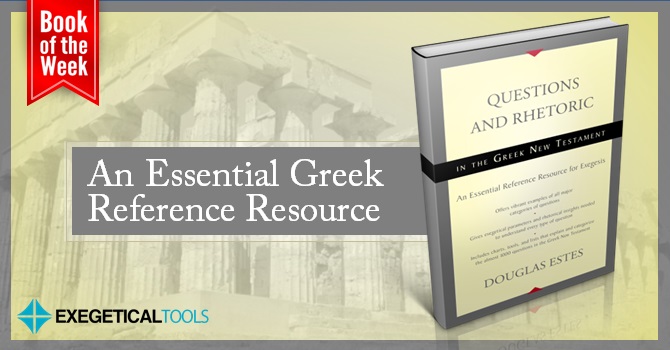There are around 1,000 questions in the Greek New Testament. That’s about 15% of the sentences in the NT. Are you equipped to handle their syntax, semantics, and pragmatic effects on discourse? Douglas Estes has produces a new volume to “help you to understand and interpret the questions that the New Testament asks in a whole new way” (17).
This volume is no light read, but it’s also not so complex that you will be baffled by it (“A student does not need to be familiar with linguistics to profit from this book (though some basic knowledge of linguistics would add to the profit)” [31]). The introduction covers many of the linguistic issues surrounding “questions.” One of the main points of the book is that interpreters often deal with questions using alethic logic, which is the type of logic used to analyze propositions. Estes asserts that questions have their own logic and must be handled in a unique way, rather than simply transforming them to propositional sentences.
In this book you will learn much about linguistic features of questions and how to interpret them in the NT. For example, Estes covers:
- The syntax, semantics, and pragmatics of questions (parts 3-5 of the boo, respectively)
- Four ways questions are formed in Indo-European languages (polar, variable, alternative, and set questions)
- Twenty-three types of questions driven by semantics
- Four types of questions driven by pragmatics (generally, where the question falls within a dialogue)
- Qualities of questions such as force, bias, turn-taking, informational quality, rhetorical quality, the EGH principle and predicaments. Importantly, Estes notes that no questions are solely rhetorical, so all questions have a spectrum of informational and rhetorical quality.
- Additionally, Estes covers each type of question in six sections: Introduction, formation, rhetorical effects, case studies, further examples, and key bibliography.
Useful charts, graphs, and graphics are included throughout the book; a Scripture index and Greek word index are also included in the back.
I could provide further description of what Estes covers in the book, but it becomes too detailed too quickly for a short post here. Instead, let me suggest why this book is important and you should own it. Linguistics has become increasingly recognized by biblical scholars as indispensable for our discipline. New monographs are coming out almost monthly, applying linguistic concepts to Koine, but I have seen precious little ever produced on questions and their rhetoric in the Greek New Testament. This resource is unique, comprehensive, and promises sweet exegetical fruit.
While preparing sermons, this volume could be profitably consulted. I recently preached the parable of the good Samaritan, in which the discussion between Jesus and the law-expert includes several questions (Luke 10:25-37). Consulting Estes’ Scripture index, I find Luke 10:26 referenced under the section “Test Questions.” Test questions can be asked either to prod a hearer to try to give a reply or to see how a listener will respond (211-212). The law-expert was clearly trying to see how Jesus would respond, much in the way (as Estes notes) Pilate tested Jesus with his qusetion, “Are you the king of the Jews?” Understanding why the question is being asked is just as important (if not more important) than understanding the propositional form underlying the question.
The book is informed by modern linguistics, filled out with extra-biblical Greek citations demonstrating Estes’ wide-ranging research, and is excellently executed. I recommend you get it on your shelf and keep it around for those 1,000 questions you’ll encounter as you work through the Greek New Testament.
Preview or buy it on Amazon here.


